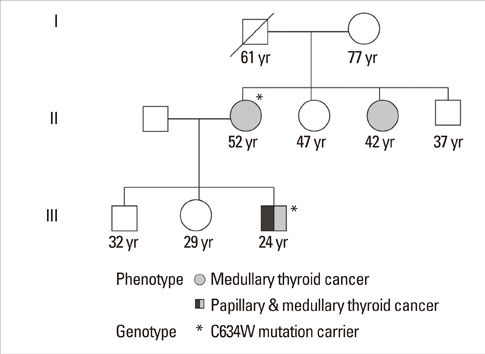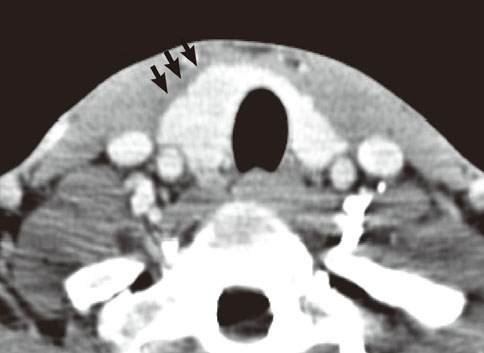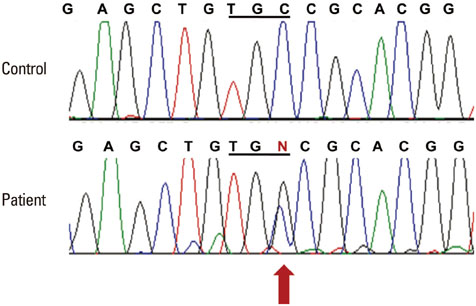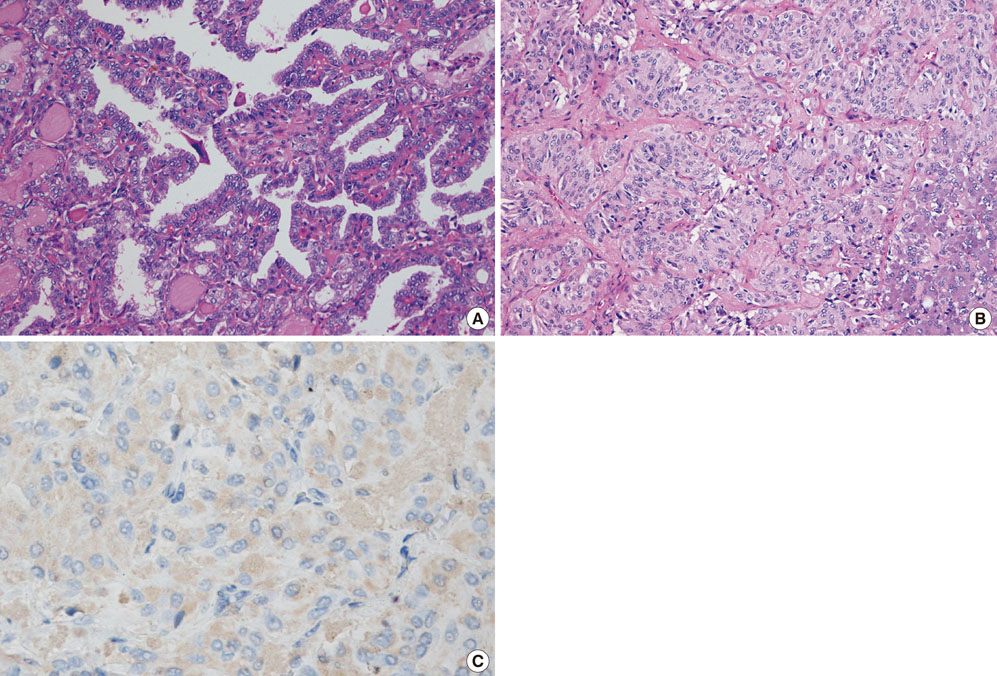Endocrinol Metab.
2010 Dec;25(4):354-359. 10.3803/EnM.2010.25.4.354.
A Case of Concurrent Papillary Thyroid Carcinoma in Familial Medullary Thyroid Microcarcinoma with a Germline C634W Mutation
- Affiliations
-
- 1Presbyterian Medical Center, Jeonju, Korea.
- 2Department of Internal Medicine, Chonbuk National University Medical School, Jeonju, Korea. parkjh@jbnu.ac.kr
- 3Department of Pathology, Chonbuk National University Medical School, Jeonju, Korea.
- 4Department of Otolaryngology, Chonbuk National University Medical School, Jeonju, Korea.
- KMID: 1497762
- DOI: http://doi.org/10.3803/EnM.2010.25.4.354
Abstract
- The origins of medullary carcinoma (MTC) and papillary carcinoma (PTC) of the thyroid are embryologically different. Tumors showing concurrent medullary and papillary features are rare and they represent less than 1% of all thyroid malignancies. Hereditary MTC is an autosomal dominantly inherited disease which is genetically determined as part of the MEN 2A, MEN 2B, or variants of MEN 2A such as familial MTC. Germline mutations of the RET gene are the underlying cause of the majority of cases of hereditary medullary carcinomas. The pathogenesis of concurrent PTC with familial MTC has rarely been known. Genetic analysis of the RET oncogene has so far provided conflicting results. Here we describe a family whose sibling was affected by both PTC & MTC, and the family carried a germ-line point mutation in the RET extracellular domain that converted cysteine 634 into tryptophan (C634W).
Keyword
MeSH Terms
Figure
Reference
-
1. Lee MH, Koh CS, Lee MC, Cho BY, Moon DH, Choi CW, Oh SK, Choe KJ, Park SH, Kim YI. Clinical study on thyroid cancer (The 3rd Report). Korean J Nucl Med. 1986. 20:59–65.2. Hong EK, Lee JD. A national study on biopsy-confirmed thyroid diseases among Koreans: an analysis of 7758 cases. J Korean Med Sci. 1990. 5:1–12.3. Jeon JS, Kim WB, Chung HK, Cho BY, Lee HK, Koh CS, Park DJ, Kim SW. Analysis of prognostic factors determining the recurrences in patients with papillary thyroid cancer after surgical treatment. J Korean Soc Endocrinol. 1997. 12:421–432.4. Rey JM, Brouillet JP, Fonteneau-Allaire J, Boneu A, Bastie D, Maudelonde T, Pujol P. Novel germline RET mutation segregating with papillary thyroid carcinomas. Genes Chromosomes Cancer. 2001. 32:390–391.5. Mclver B, Goellner JR, Hay ID. Mixed medullary-papillary thyroid carcinoma in a patient with multiple endocrine neoplasia type 2B (MEN 2B). Thyroid. 1996. 6:Suppl 1. 16.6. Orlandi F, Chiefari E, Caraci P, Mussa A, Gonzatto I, De Giuli P, Giuffrida D, Angeli A, Filetti S. RET proto-oncogene mutation in a mixed medullary-follicular thyroid carcinoma. J Endocrinol Invest. 2001. 24:51–55.7. Papi G, Corrado S, Pomponi MG, Carapezzi C, Cesinaro A, LiVolsi VA. Concurrent lymph node metastases of medullary and papillary thyroid carcinoma in a case with RET oncogene germline mutation. Endocr Pathol. 2003. 14:269–276.8. Melillo RM, Cirafici AM, De Falco V, Bellantoni M, Chiappetta G, Fusco A, Carlomagno F, Picascia A, Tramontano D, Tallini G, Santoro M. The oncogenic activity of RET point mutants for follicular thyroid cells may account for the occurrence of papillary thyroid carcinoma in patients affected by familial medullary thyroid carcinoma. Am J Pathol. 2004. 165:511–521.9. Fugazzola L, Cerutti N, Mannavola D, Ghilardi G, Alberti L, Romoli R, Beck-Peccoz P. Multigenerational familial medullary thyroid cancer (FMTC): evidence for FMTC phenocopies and association with papillary thyroid cancer. Clin Endocrinol (Oxf). 2002. 56:53–63.10. Modigliani E, Franc B, Niccoli-sire P. Diagnosis and treatment of medullary thyroid cancer. Baillieres Best Pract Res Clin Endocrinol Metab. 2000. 14:631–649.11. Brandi ML, Gagel RF, Angeli A, Bilezikian JP, Beck-Peccoz P, Bordi C, Conte-Devolx B, Falchetti A, Gheri RG, Libroia A, Lips CJ, Lombardi G, Mannelli M, Pacini F, Ponder BA, Raue F, Skogseid B, Tamburrano G, Thakker RV, Thompson NW, Tomassetti P, Tonelli F, Wells SA Jr, Marx SJ. Guidelines for diagnosis and therapy of MEN type 1 and type 2. J Clin Endocrinol Metab. 2001. 86:5658–5671.12. Kim HH, Kim HJ, Chung YJ, Min YK, Lee MS, Lee MK, Kim KW, Ki CS, Kim JW, Chung JH. Analysis of RET proto-oncogene mutation in Korean patients with medullary thyroid carcinomas. J Korean Soc Endocrinol. 2003. 18:360–370.13. Shiroko T, Yokoo N, Okamoto K, Kitakado Y, Azuma H, Fukui T, Tanaka C. Mixed medullary-papillary carcinoma of the thyroid with lymph node metastases: report of a case. Surg Today. 2001. 31:317–321.14. Apel RL, Alpert LC, Rizzo A, LiVolsi VA, Asa SL. A metastasizing composite carcinoma of the thyroid with distinct medullary and papillary components. Arch Pathol Lab Med. 1994. 118:1143–1147.15. Tseleni-Balafouta S, Grigorakis SI, Alevizaki M, Karaiskos C, Davaris P, Koutras DA. Simultaneous occurrence of a medullary and papillary thyroid carcinoma in the same patient. Gen Diagn Pathol. 1997. 142:371–374.16. Ljungberg O, Ericsson UB, Bondeson L, Thorell J. A compound follicular-parafollicular cell carcinoma of the thyroid: a new tumor entity? Cancer. 1983. 52:1053–1061.17. Volante M, Papotti M, Roth J, Saremaslani P, Speel EJ, Lloyd RV, Carney JA, Heitz PU, Bussolati G, Komminoth P. Mixed medullary-follicular thyroid carcinoma. Molecular evidence for a dual origin of tumor components. Am J Pathol. 1999. 155:1499–1509.18. Kim JK, Chung HW, Seo HS, Kim DJ, Chung SS, Song YD, Kwon KH, Jin YM, Lee MK, Lim SK, Kim IJ, Kang HC, Park JH, Park JG. A case of papillary thyroid carcinoma combined with multiple endocrine neoplasia type 2A. J Korean Soc Endocrinol. 2002. 17:730–738.19. Reynolds L, Jones K, Winton DJ, Cranston A, Houghton C, Howard L, Ponder BA, Smith DP. C-cell and thyroid epithelial tumours and altered follicular development in transgenic mice expressing the long isoform of MEN 2A RET. Oncogene. 2001. 20:3986–3994.20. Bunone G, Uggeri M, Mondellini P, Pierotti MA, Bongarzone I. RET receptor expression in thyroid follicular epithelial cell-derived tumors. Cancer Res. 2000. 60:2845–2849.
- Full Text Links
- Actions
-
Cited
- CITED
-
- Close
- Share
- Similar articles
-
- Concurrent Medullay and Papillary Carcinoma of the Thyroid
- Concurrent Papillary and Medullary Carcinoma of the Thyroid Gland
- A Case of Concurrent Medullary and Papillary Carcinoma of the Thyroid Gland
- A Case of Concurrent Papillary and Medullary Thyroid Carcinomas Detected as Recurrent Medullary Carcinoma after Initial Surgery for Papillary Carcinoma
- Medullary and Papillary Thyroid Carcinoma as a Collision Tumor: Report of Five Cases





